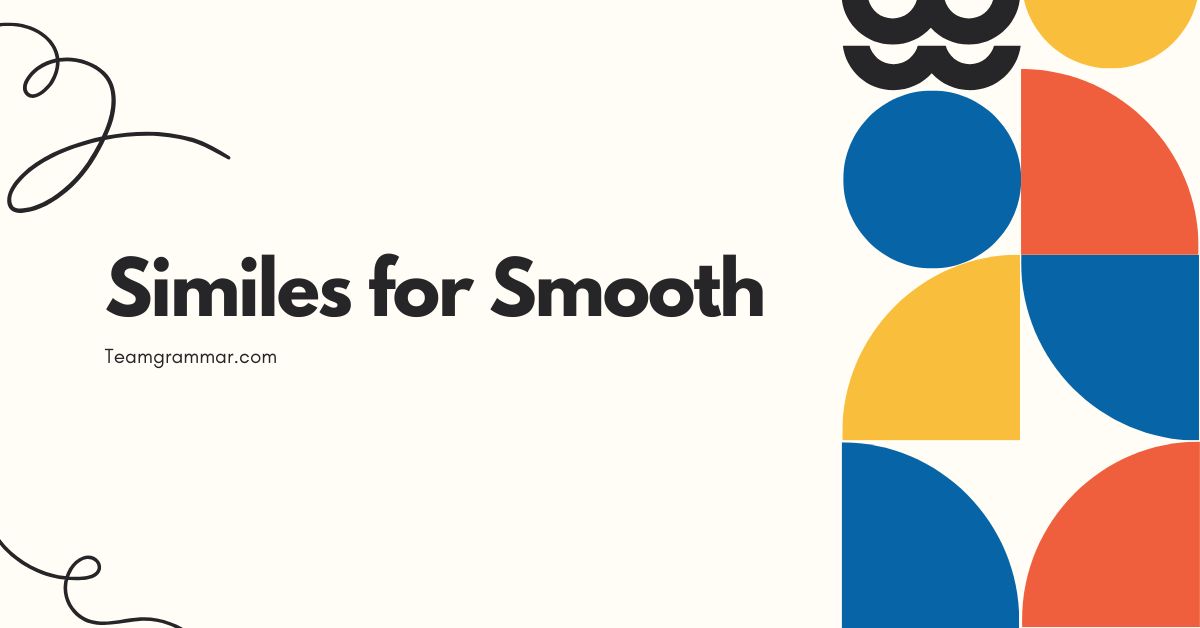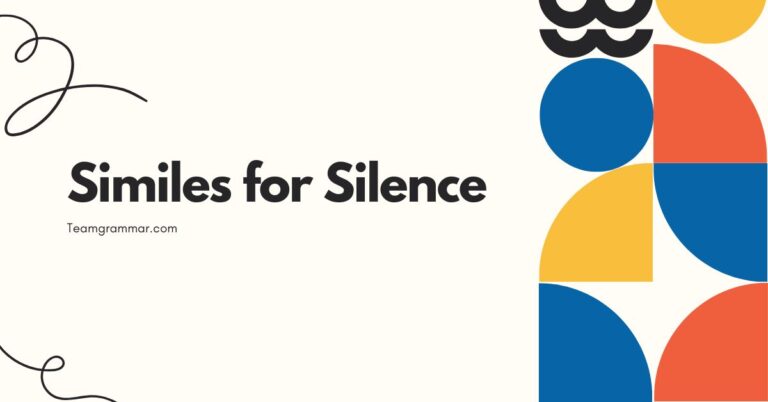31 Similes for Smooth: Enhancing Your Descriptive Language
Understanding and using similes effectively can significantly enrich your descriptive writing and communication skills. Similes, a type of figurative language, allow you to create vivid and relatable comparisons, making your writing more engaging and impactful.
This article provides a comprehensive guide to similes for the word “smooth,” exploring various examples, usage rules, common mistakes, and practice exercises. Whether you’re a student, writer, or language enthusiast, this guide will help you master the art of using similes to describe smoothness in diverse and creative ways.
By the end of this guide, you’ll have a strong grasp of how to craft compelling similes that evoke the sensation of smoothness, enhancing your ability to paint clear and evocative pictures with words. We’ll cover everything from basic definitions to advanced usage, ensuring that you’re well-equipped to use these similes confidently and correctly in your writing and speech.
Table of Contents
- Introduction
- Definition of Simile
- Structural Breakdown of Similes
- Categories of Similes for Smooth
- Examples of Similes for Smooth
- Usage Rules for Similes
- Common Mistakes When Using Similes
- Practice Exercises
- Advanced Topics in Simile Usage
- Frequently Asked Questions (FAQ)
- Conclusion
Definition of Simile
Asimileis a figure of speech that compares two unlike things using the words “like” or “as.” The purpose of a simile is to create a vivid image or convey a particular quality by associating it with something familiar to the reader or listener. Similes are essential tools for writers and speakers who want to make their descriptions more engaging and memorable.
They help to paint a picture with words, making abstract concepts more concrete and relatable.
In essence, a simile highlights a similarity between two dissimilar things, providing a fresh perspective and enhancing understanding. It serves to illustrate a quality, feeling, or state by drawing a parallel to something else that shares a similar characteristic.
For instance, saying “her skin was as smooth as silk” uses the tactile quality of silk to describe the texture of someone’s skin, making the description more sensory and impactful.
Similes are often contrasted with metaphors, which also compare two unlike things but do so by stating that one thing *is* the other, rather than merely being *like* it. While both similes and metaphors enrich language, similes provide a more explicit comparison, making them easier to identify and use, especially for those learning the nuances of figurative language.
Classification of Similes
Similes can be classified based on the type of comparison they make. Some focus on sensory experiences (touch, sight, sound), while others emphasize abstract qualities or emotional states.
Understanding these classifications can help you choose the most effective simile for your intended purpose.
Sensory Similes: These involve comparisons that relate to the five senses. For example, “smooth like velvet” appeals to the sense of touch, while “bright as the sun” appeals to sight.
Abstract Similes: These compare abstract concepts or qualities. For instance, “as smooth as a well-rehearsed plan” compares the quality of smoothness to the execution of a plan.
Emotional Similes: These relate to emotions or feelings. For example, “as smooth as a calming breeze” can evoke a sense of peace and tranquility.
Function of Similes
The primary function of a simile is to enhance description and create a more vivid and relatable image in the reader’s mind. Similes can also be used to:
- Clarify: By comparing something unfamiliar to something familiar, similes can make complex ideas easier to understand.
- Emphasize: They can highlight a particular quality or characteristic.
- Evoke Emotion: Similes can create a specific mood or feeling.
- Add Style: They can make writing more engaging and interesting.
Contexts for Using Similes
Similes are versatile and can be used in a variety of contexts, including:
- Literature: In novels, poems, and short stories, similes add depth and richness to the narrative.
- Everyday Speech: In casual conversations, similes can make your descriptions more expressive.
- Technical Writing: In explaining complex concepts, similes can simplify and clarify information.
- Advertising: In marketing, similes can make products more appealing by associating them with desirable qualities.
Structural Breakdown of Similes
Similes typically follow a simple structure, making them easy to identify and construct. Understanding this structure is key to using similes effectively.
A simile consists of three main components:
- The Subject: The thing being described.
- The Connecting Word: Usually “like” or “as.”
- The Object of Comparison: The thing to which the subject is being compared.
The basic formula for a simile is: Subject + Connecting Word + Object of Comparison.
For example, in the simile “Her voice was as smooth as honey,” “her voice” is the subject, “as” is the connecting word, and “honey” is the object of comparison. This structure helps to clearly establish the comparison and make the meaning easily understandable.
It’s important that the object of comparison shares a relevant characteristic with the subject. In this case, honey is known for its smooth texture, making it an effective comparison for the smoothness of someone’s voice.
The strength of a simile lies in the relevance and clarity of the comparison.
Common Patterns in Simile Construction
While the basic structure remains consistent, there are a few common patterns you’ll see in simile construction:
- As + Adjective + As: This pattern emphasizes a specific quality. For example, “as smooth as glass.”
- Like + Noun: This pattern compares the subject directly to a noun. For example, “smooth like butter.”
- Verb + Like: This pattern uses a verb to describe the action of the subject in comparison to something else. For example, “glides like silk.”
Grammatical Rules for Similes
While similes are a form of figurative language and therefore allow for some creative license, there are still grammatical rules to keep in mind:
- Agreement: Ensure that the subject and object of comparison agree in number. For example, “His words were as smooth as silk” (plural subject, plural comparison).
- Clarity: The comparison should be clear and easily understood. Avoid obscure or confusing references.
- Relevance: The object of comparison should share a relevant characteristic with the subject.
Categories of Similes for Smooth
Similes for “smooth” can be categorized based on the specific type of smoothness they describe. This can help you choose the most appropriate simile for the context.
Similes for Texture
These similes focus on the tactile sensation of smoothness. They often involve comparisons to materials known for their smooth texture.
Examples:
- As smooth as silk
- Like polished marble
- As smooth as velvet
- Like a baby’s skin
Similes for Motion
These similes describe the smoothness of movement or flow. They often involve comparisons to liquids or gliding objects.
Examples:
- As smooth as flowing water
- Like a gliding swan
- As smooth as a skater on ice
- Like a well-oiled machine
Similes for Appearance
These similes focus on the visual aspect of smoothness, often describing surfaces or objects.
Examples:
- As smooth as glass
- Like a mirror’s surface
- As smooth as a still lake
- Like a polished gem
Similes for Abstract Concepts
These similes extend the concept of smoothness to abstract ideas, such as plans, conversations, or performances.
Examples:
- As smooth as a well-rehearsed plan
- Like a seamless transition
- As smooth as a practiced speech
- Like a flawless performance
Examples of Similes for Smooth
The following tables provide extensive examples of similes for “smooth,” categorized by the type of smoothness they describe. These examples will help you understand how to use similes effectively in different contexts.
Table 1: Similes for Smooth Texture
This table showcases similes that emphasize the tactile quality of smoothness, comparing it to various materials and surfaces known for their smooth feel.
| Simile | Explanation |
|---|---|
| As smooth as silk | Compares the texture to the luxurious feel of silk. |
| Like polished marble | Compares the texture to the refined surface of polished marble. |
| As smooth as velvet | Compares the texture to the soft, plush feel of velvet. |
| Like a baby’s skin | Compares the texture to the delicate, soft skin of a baby. |
| As smooth as butter | Compares the texture to the soft, spreadable consistency of butter. |
| Like satin | Compares the texture to the sleek, glossy fabric of satin. |
| As smooth as a pebble worn by the sea | Compares the texture to the naturally smoothed surface of a sea-worn pebble. |
| Like a freshly paved road | Compares the texture to the even, undisturbed surface of a new road. |
| As smooth as a billiard ball | Compares the texture to the perfectly round and polished surface of a billiard ball. |
| Like a waxed floor | Compares the texture to the glossy, even surface of a waxed floor. |
| As smooth as cream | Compares the texture to the rich, velvety feel of cream. |
| Like a polished gemstone | Compares the texture to the flawless, reflective surface of a polished gem. |
| As smooth as a dolphin’s skin | Compares the texture to the sleek, hydrodynamic skin of a dolphin. |
| Like a bar of soap | Compares the texture to the slippery, even surface of a bar of soap. |
| As smooth as a river stone | Compares the texture to the naturally polished surface of a river stone. |
| Like a well-worn leather | Compares the texture to the softened, supple feel of well-worn leather. |
| As smooth as glass | Compares the texture to the sleek, unbroken surface of glass. |
| Like a greased pan | Compares the texture to the slippery surface of a greased pan. |
| As smooth as a mirror | Compares the texture to the flawless, reflective surface of a mirror. |
| Like a polished table | Compares the texture to the refined surface of polished table. |
| As smooth as a glazed tile | Compares the texture to the sleek, waterproof surface of a glazed tile. |
| Like a polished spoon | Compares the texture to the refined surface of polished spoon. |
| As smooth as a new coin | Compares the texture to the flawless, reflective surface of a new coin. |
| Like a polished doorknob | Compares the texture to the refined surface of polished doorknob. |
Table 2: Similes for Smooth Motion
This table focuses on similes that describe smooth movement, comparing it to the effortless flow of liquids, glides, and well-coordinated actions.
| Simile | Explanation |
|---|---|
| As smooth as flowing water | Compares the motion to the continuous, unimpeded flow of water. |
| Like a gliding swan | Compares the motion to the graceful, effortless glide of a swan. |
| As smooth as a skater on ice | Compares the motion to the fluid, controlled movement of a skater on ice. |
| Like a well-oiled machine | Compares the motion to the efficient, friction-free operation of a well-maintained machine. |
| As smooth as a river flowing to the sea | Compares the motion to the continuous, unimpeded flow of river. |
| Like a breeze through the trees | Compares the motion to the fluid, controlled movement of a breeze. |
| As smooth as a dance across the floor | Compares the motion to the fluid, controlled movement of a dancer. |
| Like clouds drifting across the sky | Compares the motion to the fluid, controlled movement of clouds. |
| As smooth as a train on the tracks | Compares the motion to the fluid, controlled movement of a train. |
| Like a boat on the water | Compares the motion to the fluid, controlled movement of a boat. |
| As smooth as a wheel turning | Compares the motion to the fluid, controlled movement of a wheel. |
| Like a snake slithering | Compares the motion to the fluid, controlled movement of a snake. |
| As smooth as a car on a highway | Compares the motion to the fluid, controlled movement of a car. |
| Like a bird gliding | Compares the motion to the fluid, controlled movement of a bird. |
| As smooth as a plane in flight | Compares the motion to the fluid, controlled movement of a plane. |
| Like a horse galloping | Compares the motion to the fluid, controlled movement of a horse. |
| As smooth as a cheetah running | Compares the motion to the fluid, controlled movement of a cheetah. |
| Like a rocket launching | Compares the motion to the fluid, controlled movement of a rocket. |
| As smooth as a roller coaster | Compares the motion to the fluid, controlled movement of a roller coaster. |
| Like a waterfall falling | Compares the motion to the fluid, controlled movement of a waterfall. |
| As smooth as a ball rolling | Compares the motion to the fluid, controlled movement of a rolling ball. |
| Like a swing swinging | Compares the motion to the fluid, controlled movement of a swing. |
| As smooth as a pendulum | Compares the motion to the fluid, controlled movement of a pendulum. |
Table 3: Similes for Abstract Smoothness
This table illustrates similes that extend the idea of “smooth” to abstract concepts, such as plans, conversations, and performances.
| Simile | Explanation |
|---|---|
| As smooth as a well-rehearsed plan | Compares the execution of a plan to the seamlessness of a well-rehearsed performance. |
| Like a seamless transition | Compares a transition to something that is perfectly connected without any interruption. |
| As smooth as a practiced speech | Compares the delivery of a speech to the polished, effortless quality of a practiced performance. |
| Like a flawless performance | Compares the performance to something that is perfectly executed without any mistakes. |
| As smooth as a diplomatic negotiation | Compares the negotiation to something that is free of conflict. |
| Like a well-organized meeting | Compares the meeting to something that is perfectly executed. |
| As smooth as a perfectly timed play | Compares the play to something that is perfectly executed. |
| Like a well-written poem | Compares the poem to something that is perfectly executed. |
| As smooth as a well-oiled bureaucracy | Compares the bureaucracy to something that is perfectly executed. |
| Like a well-run operation | Compares the operation to something that is perfectly executed. |
| As smooth as a perfect algorithm | Compares the algorithm to something that is perfectly executed. |
| Like a well-designed system | Compares the system to something that is perfectly executed. |
| As smooth as a well-crafted argument | Compares the argument to something that is perfectly executed. |
| Like a well-managed project | Compares the project to something that is perfectly executed. |
| As smooth as a perfect landing | Compares the landing to something that is perfectly executed. |
| Like a well-edited film | Compares the film to something that is perfectly executed. |
| As smooth as a well-composed melody | Compares the melody to something that is perfectly executed. |
| Like a well-mixed cocktail | Compares the cocktail to something that is perfectly executed. |
| As smooth as a well-balanced equation | Compares the equation to something that is perfectly executed. |
| Like a well-tuned engine | Compares the engine to something that is perfectly executed. |
| As smooth as a well-integrated team | Compares the team to something that is perfectly executed. |
| Like a well-executed strategy | Compares the strategy to something that is perfectly executed. |
| As smooth as a well-orchestrated event | Compares the event to something that is perfectly executed. |
Usage Rules for Similes
Using similes effectively requires adherence to certain rules to ensure clarity and impact. These rules cover relevance, originality, and grammatical correctness.
Relevance and Appropriateness
The most important rule is that the comparison must be relevant and appropriate. The object of comparison should share a clear and recognizable characteristic with the subject.
For example, comparing a rough surface to “sandpaper” is relevant because both are known for their abrasive texture. However, comparing it to “sunshine” would be irrelevant and confusing.
Consider the context in which you are using the simile. A simile that works well in one situation may not be appropriate in another.
The tone, audience, and purpose of your writing or speech should all influence your choice of similes.
Originality and Freshness
While some similes are common and widely understood, strive for originality to make your writing more engaging. Overused similes can become clichés and lose their impact.
Instead of saying “as smooth as silk,” which is a common simile, try “as smooth as a dolphin’s skin” to offer a fresher and more vivid comparison.
Think creatively and look for less obvious connections between things. The more unique and unexpected your simile, the more likely it is to capture the reader’s attention and leave a lasting impression.
Grammatical Correctness
Ensure that your similes are grammatically correct. The subject and object of comparison should agree in number, and the simile should fit seamlessly into the sentence structure.
For example, “The road was as smooth as glass” is grammatically correct, while “The road were as smooth as glass” is incorrect because “road” is singular.
Pay attention to the tense of the verb and ensure that it is consistent throughout the sentence. Also, avoid awkward phrasing or word choices that could detract from the clarity and impact of the simile.
Avoiding Clichés
Clichés are overused expressions that have lost their original impact. While they may be easily understood, they often lack the freshness and originality needed to make your writing stand out.
Avoid common similes like “as smooth as silk” or “like butter,” and instead, try to come up with your own unique comparisons.
One way to avoid clichés is to think about specific details and sensory experiences that relate to the quality you are trying to describe. Instead of relying on a generic simile, focus on creating a more personalized and evocative comparison.
Common Mistakes When Using Similes
Even experienced writers can make mistakes when using similes. Understanding these common errors can help you avoid them and use similes more effectively.
Irrelevant Comparisons
One of the most common mistakes is making comparisons that are irrelevant or unclear. The object of comparison should share a clear and recognizable characteristic with the subject.
If the connection is too obscure or tenuous, the simile will be confusing and ineffective.
Incorrect: “His explanation was as smooth as a cactus.” (Cacti are not typically associated with smoothness.)
Correct: “His explanation was as smooth as a practiced speech.” (Practiced speeches are known for their smooth delivery.)
Overused Similes (Clichés)
Using clichés can make your writing seem unoriginal and uninspired. Avoid common similes that have lost their impact through overuse.
Incorrect: “Her skin was as smooth as silk.” (This is a very common and often overused simile.)
Correct: “Her skin was as smooth as polished jade.” (This is a more unique and evocative comparison.)
Grammatical Errors
Grammatical errors can undermine the effectiveness of your similes. Ensure that the subject and object of comparison agree in number and that the simile fits seamlessly into the sentence structure.
Incorrect: “The water were as smooth as glass.” (The subject “water” is singular, but the verb “were” is plural.)
Correct: “The water was as smooth as glass.” (The subject and verb agree in number.)
Mixing Metaphors and Similes
Confusing metaphors and similes can lead to illogical or nonsensical comparisons. Remember that similes use “like” or “as” to make a comparison, while metaphors state that one thing *is* another.
Incorrect: “The plan was a smooth river, like it would flow effortlessly.” (This mixes a metaphor “smooth river” with a simile using “like.”)
Correct: “The plan was like a smooth river, flowing effortlessly.” (This uses a simile to compare the plan to a smooth river.)
Practice Exercises
Test your understanding of similes for “smooth” with the following exercises. Fill in the blanks with appropriate similes to complete the sentences.
Exercise 1: Completing Similes
Fill in the blanks with appropriate similes to describe smoothness.
| Question | Answer |
|---|---|
| 1. The surface of the table was ________. | As smooth as glass |
| 2. Her voice was ________ when she sang the lullaby. | As smooth as honey |
| 3. The skater moved ________ across the ice. | Like a gliding swan |
| 4. The plan unfolded ________. | As smooth as a well-rehearsed plan |
| 5. The lotion made her skin feel ________. | Like a baby’s skin |
| 6. The car ride was ________. | As smooth as a well-paved road |
| 7. His apology was ________. | As smooth as a diplomatic negotiation |
| 8. The transition between scenes was ________. | Like a seamless transition |
| 9. The engine ran ________ after the tune-up. | Like a well-oiled machine |
| 10. The presentation was ________. | As smooth as a practiced speech |
Exercise 2: Identifying Correct Similes
Choose the correct simile from the options provided.
| Question | Answer |
|---|---|
1. The chocolate melted ________.
|
b) As smooth as butter |
2. The dance was ________.
|
c) As smooth as a flowing river |
3. The gemstone was ________.
|
b) As smooth as a polished gemstone |
4. The conversation flowed ________.
|
b) As smooth as a diplomatic negotiation |
5. The surface of the ice was ________.
|
b) As smooth as glass |
6. The new operating system was ________.
|
b) As smooth as a well-designed system |
7. The singer’s voice was ________.
|
b) As smooth as velvet |
8. The presentation was ________.
|
b) As smooth as a practiced speech |
9. The project management was ________.
|
b) As smooth as a well-managed project |
10. The delivery was ________.
|
b) As smooth as a perfect landing |
Advanced Topics in Simile Usage
For advanced learners, exploring more complex aspects of simile usage can further enhance their writing and communication skills. This includes understanding the nuances of creating original similes, using similes for specific rhetorical effects, and analyzing similes in literature.
Creating Original Similes
While it’s easy to rely on common similes, creating original comparisons can make your writing stand out. This requires a keen eye for detail and a creative approach to language.
Start by identifying the specific qualities you want to emphasize and then brainstorm a list of things that share those qualities. Look for unexpected connections and try to create similes that are both vivid and memorable.
For example, instead of saying “as smooth as silk,” you might say “as smooth as the surface of a freshly Zambonied ice rink” to create a more specific and evocative image.
Similes for Rhetorical Effect
Similes can be used to achieve specific rhetorical effects, such as persuasion, humor, or emotional impact. Understanding these effects can help you use similes more strategically in your writing and speech.
Persuasion: Similes can be used to make an argument more compelling by comparing it to something that is widely accepted or understood. For example, “Investing in education is as smooth as paving the way for future success.”
Humor: Similes can be used to create humor by making unexpected or absurd comparisons. For example, “His dance moves were as smooth as a rusty robot.”
Emotional Impact: Similes can be used to evoke specific emotions by comparing something to something that is emotionally charged. For example, “The loss was as smooth as a knife cutting through his heart.”
Analyzing Similes in Literature
Analyzing how similes are used in literature can provide valuable insights into the art of simile construction. Pay attention to the specific comparisons that authors make, the effects they achieve, and the overall impact of the similes on the text.
Consider the context in which the similes are used and how they contribute to the themes and meanings of the work.
For example, in F. Scott Fitzgerald’s *The Great Gatsby*, the simile “The city seen from the Queensboro Bridge is always the city seen for the first time, in its first wild promise of all the mystery and the beauty in the world” evokes a sense of wonder and possibility, reflecting the protagonist’s idealistic vision of the future.
Frequently Asked Questions (FAQ)
Here are some frequently asked questions about similes, particularly those related to describing “smoothness,” along with detailed answers to help you understand the concept better.
- What is the difference between a simile and a metaphor?
A simile compares two unlike things using “like” or “as,” while a metaphor states that one thing *is* another. For example, “Her skin was *like* silk” is a simile, while “Her skin *was* silk” is a metaphor. Similes make an explicit comparison, while metaphors imply a comparison.
- Why are similes important in writing?
Similes enhance description, create vivid images, clarify complex ideas, emphasize qualities, evoke emotions, and add style to writing, making it more engaging and memorable for the reader.
- How can I avoid using clichés when creating similes for “smooth”?
To avoid clichés, think creatively, look for less obvious connections, and focus on specific details and sensory experiences related to smoothness. Instead of “as smooth as silk,” try “as smooth as a dolphin’s skin” or “as smooth as freshly polished jade.”
- What are some common categories of similes for “smooth”?
Common categories include similes for texture (e.g., as smooth as velvet), motion (e.g., like a gliding swan), appearance (e.g., as smooth as glass), and abstract concepts (e.g., as smooth as a well-rehearsed plan).
- How do I ensure that my similes are grammatically correct?
Ensure that the subject and object of comparison agree in number, and that the simile fits seamlessly into the sentence structure. Pay attention to verb tense and avoid awkward phrasing.
- What should I do
whether a simile is relevant and appropriate?
Ensure that the object of comparison shares a clear and recognizable characteristic with the subject. The connection should be logical and easily understood by the reader. Consider the context, tone, audience, and purpose of your writing or speech.
- Can similes be used in technical writing?
Yes, similes can be used in technical writing to simplify complex concepts and make them more understandable. However, it’s important to use similes judiciously and ensure that they are clear, accurate, and relevant to the topic.
- How can I analyze similes in literature to improve my own writing?
Pay attention to the specific comparisons that authors make, the effects they achieve, and the overall impact of the similes on the text. Consider the context in which the similes are used and how they contribute to the themes and meanings of the work.
- What are some advanced techniques for using similes effectively?
Advanced techniques include creating original similes, using similes for specific rhetorical effects (such as persuasion, humor, or emotional impact), and analyzing similes in literature to gain a deeper understanding of their use.
- How can I practice using similes to describe “smoothness”?
Practice by completing simile exercises, identifying correct similes in sentences, and creating your own original similes to describe various smooth textures, motions, appearances, and abstract concepts.
Conclusion
Mastering the use of similes can significantly enhance your descriptive writing and communication skills. By understanding the definition, structure, and categories of similes for “smooth,” you can create vivid and engaging comparisons that capture the essence of smoothness in various contexts.
Remember to adhere to usage rules, avoid common mistakes, and practice regularly to refine your skills.
Whether you’re a student, writer, or language enthusiast, the ability to craft compelling similes will empower you to express your ideas more effectively and make your writing more memorable. So, embrace the art of simile creation and let your words flow as smoothly as the comparisons you make.







